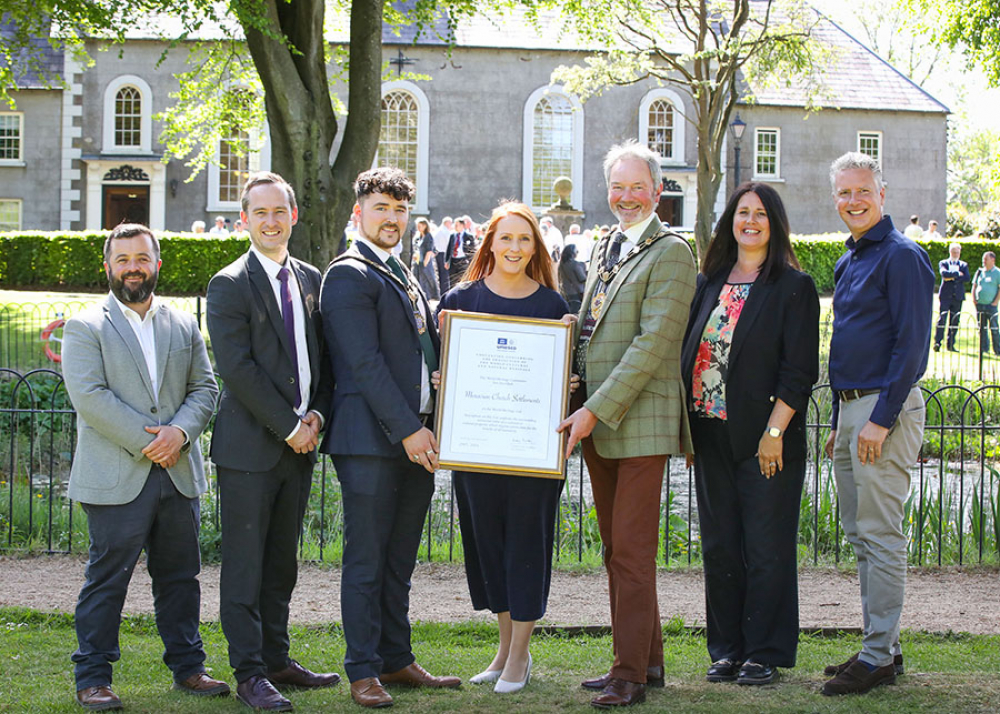Northern Irelands newest World Heritage Site presented with official UNESCO Certificates
Friday 16 May 2025
After many years of effort, the Moravian village of Gracehill in Co. Antrim, Northern Ireland, was designated as a UNESCO World Heritage Site at the 46th World Heritage Committee of UNESCO held in New Delhi, India in July 2024.

The designation is entitled “Moravian Church Settlements” and is a transnational designation meaning that it is one “site” with a number of international component parts; namely Bethlehem, (Pennsylvania, USA), Herrnhut (Germany) and the already inscribed Christiansfeld (Denmark) in addition to Gracehill.
Her Excellenc,y Ambassador Anna Nsubuga, UK Ambassador and Permanent Delegate to UNESCO in Paris, visited the village on 15 May and at a celebratory event in the village presented the official certificate of Inscription to an audience of residents, local politicians and visiting dignitaries.
Gracehill, in common with the other international settlements, is an early example of town planning reflecting the timeless values of education, equality, industry, tolerance, and spirituality that have been at the heart of this community since 1759. Its intact core of historic listed buildings, Moravian Church, central Square, and burial ground or God’s Acre as it is known, featured in the nomination.
Each of the Settlements nominated demonstrate different phases in the development of Moravian planning. Gracehill stands out as having been constructed in a grid plan with a central square and a very clear and complete ‘gender axis’. Since its foundation Gracehill was well known for its international links which continue today.
Gracehill is historically renowned for its principles of religious and political tolerance, neutrality, and reconciliation, first manifested significantly during the ‘United Irishmen’s Rebellion’ of 1798 when Gracehill was seen as a place of refuge for all.
The Gracehill community have been working with international partners since 2003 to achieve World Heritage recognition so today’s ceremony is the culmination of years of effort by all involved.
Speaking following the announcement:
Communities Minister Gordon Lyons welcomed the UNESCO visit and commented: “This prestigious recognition of Gracehill raises the status of Northern Ireland as a tourist destination and the visit by UNESCO representatives today celebrates what we have to offer. The preservation of historic Gracehill has been supported by my Department since the 1970s, with the Village Catalyst programme recently restoring the Old Post Office into a community space with accommodation.
“The presentation of the Inscription certificate today acknowledges not just the historic characteristics of Gracehill, but those passionate individuals and organisations who have worked so hard to secure UNESCO Cultural World Heritage Status. I highlighted their commitment during my visit to one of the four UNESCO Moravian settlements in Bethlehem, Pennsylvania last year and pay tribute to their success again today.”
Mayor of Mid and East Antrim, Alderman William McCaughey, said: “This is a historic day for Gracehill and Mid and East Antrim. We are delighted to receive the official Certificate of Inscription for Gracehill, joining a list of some of the world’s most iconic UNESCO World Heritage sites, such as the Great Barrier Reef, the Galapagos Islands and Mount Kilimanjaro. Well done to everyone involved in bringing this forward. What an achievement!”
Dr David Johnston, Chair of Gracehill Trust said: “The prize of a cultural World Heritage listing is a huge good news story for Northern Ireland as a whole, something that everyone can share in and be proud of, with the potential to promote understanding and reconciliation and bring social, economic, environmental and cultural benefits right across the region now and for generations to come. This is a great day for Northern Ireland.”